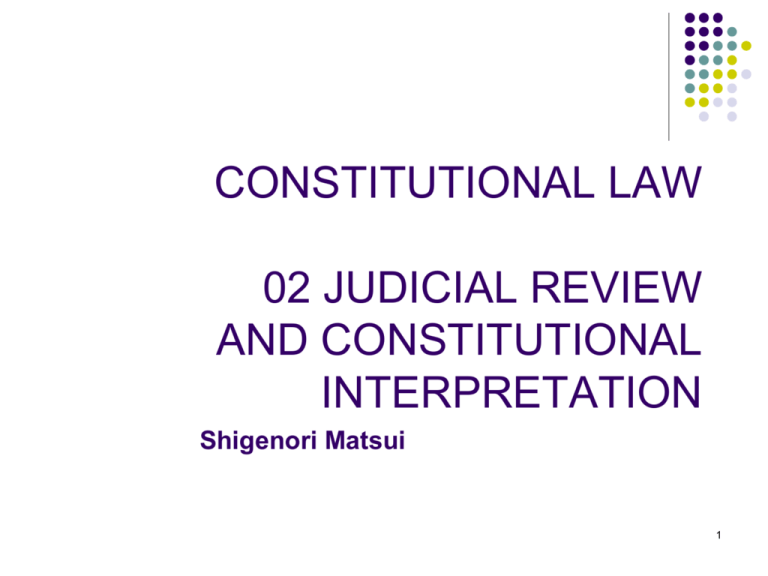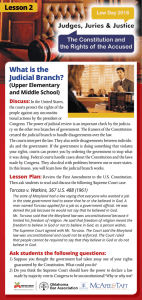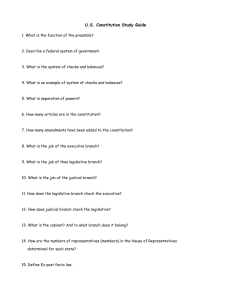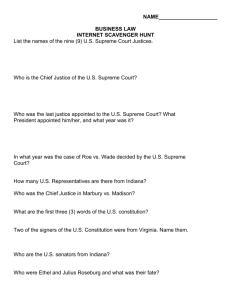I The Supreme Court of Canada - University of British Columbia
advertisement

CONSTITUTIONAL LAW 02 JUDICIAL REVIEW AND CONSTITUTIONAL INTERPRETATION Shigenori Matsui 1 INTRODUCTION The Supreme Court of Canada Legitimacy of Judicial Review How should the Constitution be Interpreted? What kind of role unwritten constitutional principles should play? 2 I The Supreme Court of Canada S. 101 of the Constitution Act, 1867, authorized the Parliament “to provide for the constitution, maintenance, and organization of a general court of appeal for Canada.” The Parliament enacted the Supreme Court Act in 1875 and established the Supreme Court of Canada. 3 4 At the time of the establishment, the Supreme Court of Canada was not exactly a final court for Canada: it was possible to appeal to the Privy Council in U.K. 5 Attempt to abolish the appeal to the Privy Council and make the Supreme Court of Canada the final court for Canada 6 The Supreme Court of Canada comprises of Chief Justice and eight associate Justices. The total number of Justices is nine. By statute, three must be chosen from Quebec. By convention, three must be chosen from Ontario, two from Western provinces, and one from Atlantic provinces. 7 8 The justices are appointed by the Governor General in Council. Each appointee must be a judge of provincial superior court or must have at least ten-years experience at the bar of the province 9 10 Quorum is five judges. Majority of cases are heard by nine judges but sometimes cases are heard by five or seven judges. 11 The Supreme Court of Canada has an appellate jurisdiction throughout Canada: it could hear and decide issue on provincial law as well. 12 13 Jurisdiction In civil and criminal cases, the leave to appeal must be issued. In criminal cases, the appeal as of right is possible if there is a dissent in the decision of the court of appeal. Governor General can refer the important question of law to the Supreme Court of Canada 14 The judgment of the Supreme Court of Canada is binding upon the case. It will become a precedent for other courts to follow. 15 S. 33 of the Constitution Act, 1982, allows the override in some Charter cases. 16 II LEGITIMACY OF JUDICIAL REVIEW Why can the courts review the constitutionality of legislation? Compare with Marbury v. Madison 17 Text of the Constitution Act, 1867 or the Constitution Act, 1982? Framers’ intent? Necessity of judicial review? 18 How can we justify judicial review in light of the democracy principle of the Constitution? Democracy is nor a cardinal principle of the Constitution? Democracy needs accomplishment of substantive values? 19 Does constitutionalism, rule of law, or protection of rights of minorities justify judicial review? 20 Sufficient public supervision over unelected judges? Dialogue theory? 21 III HOW SHOULD THE CONSTITUTION BE INTERPRETED ? Edwards v. AG for Canada (1929) The living tree doctrine 22 Is it the role of the courts to change the meaning of the Constitution to respond to the social change? How could the courts update the meaning of the Constitution? 23 Interpretivism v. Noninterpretivism Originalism v. Nonoriginalism 24 Where should the judges look to when they interpret the Constitution? 25 IV UNWRITTEN PRINCIPLES Could the courts rely upon unwritten principles to review the constitutionality? 26 Rule of law principle Roncarelli v. Duplessis [1959] Reference re Manitoba Language Rights [1985] BC v. Imperial Tobacco Canada [2005] British Columbia v. Christie, [2007] 27







